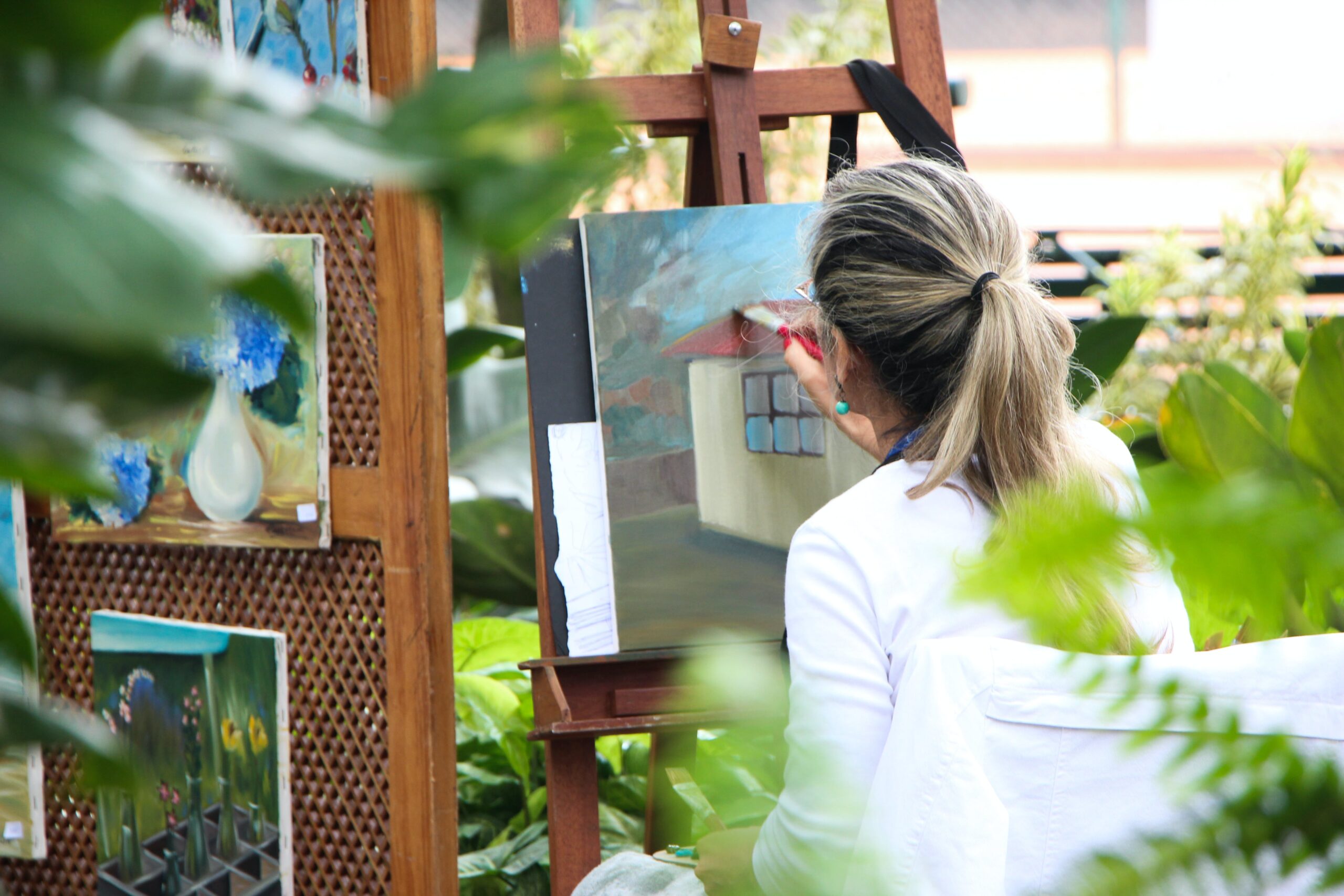Engaging in creative and expressive arts therapy provides individuals with a means to regulate their mood and emotions while discovering creative outlets for self-expression. These tools can be especially beneficial for those undergoing treatment for substance use disorders, offering alternative avenues to avoid relapse into drug or alcohol use.
What Is Creative Expressions Art Therapy?
Creative expressive arts therapy involves the creation of art as a means for people to express themselves and explore their emotions. Rooted in the belief that the creative process holds healing and therapeutic potential, art therapy establishes a safe space for creative expression in therapy, enabling the communication of feelings that may be challenging or resistant to verbalization. This process can help people in the recovery process difficult emotions and experiences, illuminating thoughts and feelings, and cultivating new coping strategies.
Engaging in creative expressive therapy not only provides relaxation and an outlet for stress-relief, but also engenders a sense of connection to self and the surrounding world. Art therapy is adaptable for individuals, families, or groups and can be effective in addressing various conditions, including addiction and co-occurring mental health conditions like anxiety, depression, or trauma.

Art therapy involves a range of modalities that cater to various preferences and therapeutic goals. Here are some examples of art therapy techniques commonly used in addiction recovery and mental health treatment:
Creative expression as therapy through painting or drawing enables people to visually represent their emotions, experiences, and aspirations. Creating symbolic or abstract art can offer a unique insight into the subconscious mind, aiding in self-discovery.
Collage involves the combination of different materials and textures to create a cohesive piece of art. It can be especially effective in exploring the complexity of emotions and experiences by layering various elements.
Sculpting with clay provides a tactile and hands-on approach to expression. The physical act of molding and shaping can be cathartic, allowing individuals to externalize and transform their emotions.
Engaging with photography encourages people to capture and reflect on meaningful images. Photo therapy involves exploring and discussing the emotions and memories evoked by the captured moments.
Utilizing digital tools for art creation provides a modern and accessible avenue for expression. Digital art platforms can be particularly useful for those who prefer technology-based forms of creative expression.
Collaborative art projects like group murals promote a sense of community and shared expression. Working together on a large-scale piece encourages communication and support among participants.
Keeping an art journal allows for consistent self-expression over time.
Combining visual elements with poetry offers a unique blend of written and visual expression. Visual poetry can be a powerful way to articulate complex feelings and experiences.
These examples show how art therapy can accommodate diverse preferences and foster creative expression. The choice of modality often depends on individual preferences, comfort levels, and therapeutic goals. Whether working individually or in a group setting, art therapy provides a rich and meaningful channel for individuals to explore, process, and communicate their journey of recovery.


How Can Creative Expression Therapy Help with Recovery?

Art therapy, or creative expression therapy, plays a crucial role in supporting recovery by offering a unique and impactful approach to healing. Creative expression therapy provides a non-verbal avenue for individuals to release and process complex emotions. Through art, individuals can externalize and explore feelings that may be challenging to articulate verbally, facilitating a therapeutic release.
The creative process encourages self-exploration and introspection. Engaging in art-making allows people to connect with their inner selves, gaining a deeper understanding of personal experiences, values, and perspectives. This self-awareness is instrumental in the recovery journey.
Creating art can lead to the development of new coping strategies. It encourages individuals to find healthy and constructive ways to navigate challenges and stressors, replacing maladaptive coping mechanisms associated with substance use.
Art-making inherently involves focusing on the present moment, promoting mindfulness. This heightened awareness can be therapeutic for individuals in recovery, helping them stay grounded and focused on their current journey.
The process of creating art often involves overcoming challenges and uncertainties. Engaging in creative expression fosters resilience by encouraging individuals to embrace mistakes, adapt to unexpected outcomes, and persevere through the creative process.
Completing an art project, no matter how small, instills a sense of accomplishment. This achievement contributes to feelings of empowerment and self-efficacy, reinforcing the idea that individuals have the capability to effect positive change in their lives.

Participating in creative expression therapy in a group setting fosters a sense of community and connection. Sharing the creative process with others in recovery can create a supportive environment, reducing feelings of isolation and building a sense of belonging.
For those who may struggle with verbal expression, creative expression therapy offers an alternative means of communication. Art can convey complex emotions and experiences in a way that transcends language barriers, enabling a deeper level of understanding.
Incorporating creative expression therapy into a comprehensive recovery plan accounts for the multifaceted nature of healing. By addressing emotional, psychological, and social aspects, this therapeutic approach contributes to a more holistic and personalized recovery journey
Engaging in creative expressive therapy not only provides relaxation and an outlet for stress-relief, but also engenders a sense of connection to self and the surrounding world. Art therapy is adaptable for individuals, families, or groups and can be effective in addressing various conditions, including addiction and co-occurring mental health conditions like anxiety, depression, or trauma.
Art therapy involves a range of modalities that cater to various preferences and therapeutic goals. Here are some examples of art therapy techniques commonly used in addiction recovery and mental health treatment:
These examples show how art therapy can accommodate diverse preferences and foster creative expression. The choice of modality often depends on individual preferences, comfort levels, and therapeutic goals. Whether working individually or in a group setting, art therapy provides a rich and meaningful channel for individuals to explore, process, and communicate their journey of recovery.


How to Find Creative Expressions Therapy for Addiction

Finding creative expression therapy for addiction involves exploring various avenues to connect with qualified professionals and programs that offer this therapeutic approach. Here are steps to guide individuals in seeking creative expression therapy for addiction:
Look for addiction treatment centers that specifically incorporate creative expression therapy into their programs. Many comprehensive treatment facilities offer a range of therapeutic modalities, including art therapy, as part of their holistic approach to recovery.
Reach out to mental health professionals such as therapists, counselors, or psychologists who specialize in addiction treatment. Inquire about their use of creative expression therapy and whether they integrate it into their treatment plans.
Some outpatient programs and counseling services may include creative expression therapy as part of their offerings. Check with local outpatient treatment centers, counseling agencies, or community mental health organizations to inquire about available services.
Art therapists specialize in using art as a therapeutic tool. Look for licensed art therapists in your area who have experience working with people in addiction recovery. They may provide individual or group sessions tailored to support the recovery process.
Community centers, support groups, or nonprofit organizations may host art or creative expression workshops specifically designed for individuals in addiction recovery. These settings can provide a supportive and communal environment for creative exploration.
If you are already enrolled in an addiction treatment program, ask your treatment providers about the availability of creative expression therapy. They may have in-house therapists or collaborations with external professionals who can incorporate these modalities into your treatment plan
Contact local art schools, studios, or community art spaces to inquire about workshops or classes tailored for individuals in addiction recovery. Some art instructors may specialize in adapting their sessions to support therapeutic goals.

Get Creative Expressions Art Therapy at Renaissance Recovery
We offer a variety of intensive outpatient treatment programs for addictions and mental health conditions at Renaissance Recovery in Southern California, incorporating evidence-based interventions with holistic therapies like art therapy.
By choosing an outpatient program, you can engage with treatment at an appropriate level of intensity, and you can also fulfill your everyday commitments.
All Renaissance treatment programs deliver personalized therapies, such as:
- Holistic interventions
- Psychotherapies (CBT and DBT)
- MAT (medication-assisted treatment)
- Group therapy
- Individual counseling
- Family therapy
- Aftercare and support
Call admissions at 866.330.9449 and access a blend of science-based and holistic addiction treatment in Orange County.
Our California rehabs connect you with:



